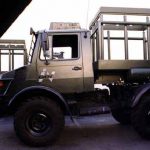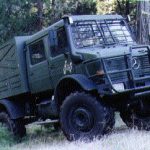Unimog designates a range of multi-purpose auto four wheel drive medium trucks produced by Mercedes-Benz, a division of Daimler AG. The name Unimog is pronounced [ˈuːnɪmɔk] in German and is an acronym for the German “UNIversal-MOtor-Gerät”,Gerät being the German word for machine or device. Daimler Benz took over manufacture of the Unimog in 1951 and they are currently built in the Mercedes truck plant in Wörth am Rhein in Germany. Another Mercedes-Benz Türk A.Ş. plant assembles Unimogs in Aksaray, Turkey. Unimogs were also built in Argentina until the first years of the 1980’s, in the González Catán factory.
The first model was designed shortly after World War II to be used in agriculture as a self-propelled machine providing a power take-off to operate saws in forests or harvesting machines on fields. It was designed with permanent 4WD with equal size wheels in order to be driven on roads at higher speeds than standard farm tractors. With their very high ground clearance and a flexible frame that is essentially a part of the suspension, Unimogs are not designed to carry as much load as regular trucks.
Due to their off-road capabilities, Unimogs can be found in jungles, mountains and deserts as military vehicles, fire fighters, expedition campers, and even in competitions like truck trials and Dakar Rally rally raids. In Western Europe, they are commonly used as snow plows, municipal equipment carriers, agricultural implements, construction equipment and road-rail vehicles.
1997 Unimog U 1300
 This was one of the vehicles used by the Hunting Party during the dinosaur roundup on Isla Sorna. For that expedition, InGen had two different variants of the 1997 U 1300, each retrofitted for a specific purpose. One variant used a large platform cage on the rear for personnel transport, which allowed groups of InGen harvesters to traverse Isla Sorna with their equipment, and fire tranquilizer darts from this platform when harvesting the free range dinosaurs on the island. This variant had a smaller cab than the other.
This was one of the vehicles used by the Hunting Party during the dinosaur roundup on Isla Sorna. For that expedition, InGen had two different variants of the 1997 U 1300, each retrofitted for a specific purpose. One variant used a large platform cage on the rear for personnel transport, which allowed groups of InGen harvesters to traverse Isla Sorna with their equipment, and fire tranquilizer darts from this platform when harvesting the free range dinosaurs on the island. This variant had a smaller cab than the other.
 The other variant was a largely unmodified “crew cab” 1997 U 1300. This model variant refers to the extended cab, which allowed room for additional passengers. Like the platform Unimog, the crew cab Unimog was modified with a grill guard, and bars on the windshield. Also like the platform Unimog, the InGen logo was stenciled on both front doors. The specific purpose of this Unimog among InGen’s fleet is not explicitly known, though it is possible it was used for transportation of supplies rather than people.
The other variant was a largely unmodified “crew cab” 1997 U 1300. This model variant refers to the extended cab, which allowed room for additional passengers. Like the platform Unimog, the crew cab Unimog was modified with a grill guard, and bars on the windshield. Also like the platform Unimog, the InGen logo was stenciled on both front doors. The specific purpose of this Unimog among InGen’s fleet is not explicitly known, though it is possible it was used for transportation of supplies rather than people.
2014 Unimog U 4000
 In his park, which was the spiritual successor to John Hammond‘s Jurassic Park, Simon Masrani equipped his Jurassic World staff with slightly modified 2014 Unimog U 4000s. These were used mostly by the veterinarian staff, the Mobile Veterinary Unit, for transporting medics and their supplies into the park to attend to sick or injured dinosaurs. One such case seen in 2015 was staff tending to a tranquilized Pachycephalosaurus, which had shorted out her tracking implant in a scuffle with another Pachycephalosaurus, and had then wandered from her designated area. These Unimogs were, like other park staff vehicles, painted silver with a horizontal blue stripe. Additionally, the Unimogs had red and white caution striping wrapped around the vehicle, a grill guard attached to the front, and emergency lights on the roof.
In his park, which was the spiritual successor to John Hammond‘s Jurassic Park, Simon Masrani equipped his Jurassic World staff with slightly modified 2014 Unimog U 4000s. These were used mostly by the veterinarian staff, the Mobile Veterinary Unit, for transporting medics and their supplies into the park to attend to sick or injured dinosaurs. One such case seen in 2015 was staff tending to a tranquilized Pachycephalosaurus, which had shorted out her tracking implant in a scuffle with another Pachycephalosaurus, and had then wandered from her designated area. These Unimogs were, like other park staff vehicles, painted silver with a horizontal blue stripe. Additionally, the Unimogs had red and white caution striping wrapped around the vehicle, a grill guard attached to the front, and emergency lights on the roof.
 Inside the rear compartment, the vehicle was stocked with medical packs, including those designed specifically for the Velociraptors and Tyrannosaurus rex, refrigerated medical supplies, shock prods for defense, and canisters containing an unknown gas, possibly either oxygen or an anesthesia. A sliding window connecting to the cab permitted communication between the driver and the staff in the rear of the vehicle.
Inside the rear compartment, the vehicle was stocked with medical packs, including those designed specifically for the Velociraptors and Tyrannosaurus rex, refrigerated medical supplies, shock prods for defense, and canisters containing an unknown gas, possibly either oxygen or an anesthesia. A sliding window connecting to the cab permitted communication between the driver and the staff in the rear of the vehicle.
During the demise of Jurassic World, Park Operations Manager Claire Dearing used one such Unimog to transport her nephews, Zach and Gray Mitchell, back to Main Street from a remote IBRIS project research outpost. During the ride, Claire and her nephews had to defend themselves from attacking Velociraptors, who switched allegiances from their human handler, Owen Grady, to that of the genetically engineered dinosaur hybrid, the Indominus rex.

